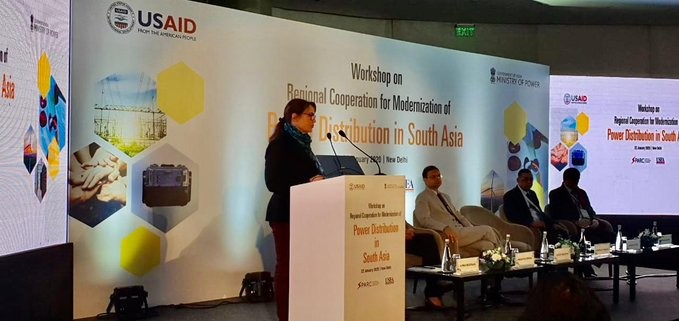India
- History
- Our Work
- Transforming Development Through Innovation & Partnership
- U.S.-India Triangular Cooperation
- Partnership for Energy Access and Security
- Partnership for Sustainable Forests in India
- Partnerships for Health
- Partnership for Education
- Partnership for Water Sanitation and Hygiene (WASH)
- Partnership for Food Security
- Partnership for Gender Equality
- Investing in Afghanistan
- Foreign Assistance Data
- Newsroom
- Newsletters and Fact Sheets
- Speeches
- Resources For Implementing Partners (RFIP)
- Careers
- Partnership Opportunities
- Success Stories
Speeches Shim

(As prepared for delivery)
Good morning honorable members on the dais, distinguished guests, ladies and gentlemen. It is my pleasure and honor to welcome you all to this workshop on “Regional Cooperation for Modernization of Power Distribution in South Asia”.
Before I begin, I would also like to thank our partners for today, Additional Secretary Sanjay Malhotra and Joint Secretary Mritunjay Narayan of the Ministry of Power. Thank you for your leadership and long-standing partnership with USAID on power sector reforms in India.
Welcome Mr. Saurabh Kumar, Managing Director of EESL. We are proud of our partnership with you in your transformative journey in pushing the boundaries and making things happen! Be it energy efficiency, electric vehicles or smart meters.
Among those present here today are also the power secretary from the Government of Sri Lanka, Ms. Perera, and Permanent Secretary of the Maldivian Ministry of Environment and Energy Musthafa. Your presence here is highly valued as it reconfirms support for our vision of an interconnected South Asia region. Thank you for your time and effort.
I also want to congratulate my colleagues at USAID, the SPARC Program, implementing partner KPMG, and USEA for gathering so many important voices in one room. If I can use power sector jargon, the room feels really charged up, and I know this has been achieved after weeks of hard work, coordination and relentless follow ups. So, I hope all who have gathered here will find this workshop highly beneficial.
South Asia is the second fastest growing region in the world. It is estimated that by 2040, Asia will account for two-thirds of the growth in global energy demand, most of which will come from South Asia.
India alone is expected to account for 30 percent of this demand. This would mean that the countries in South Asia will need to expand and improve electricity services to meet the growing needs and aspirations of their citizens and ensure energy security for all.
The United States Government has made energy one of the critical priorities of our vision for a free, open, and secure Indo-Pacific region, which spans from the west coast of the U.S. to the east coast of Africa, or from California to Kilimanjaro.
USAID is advancing this vision through the Asia Enhancing Growth and Development through Energy, or the Asia EDGE initiative, by strengthening energy security, increasing energy diversification and trade, and expanding energy access across the Indo-Pacific region.
One of the foundational pillars of the Asia EDGE initiative is the modernization of utilities across the entire electricity chain, which includes generation, transmission, and distribution.
The distribution sector is arguably one of the most critical parts of the chain. Without a strong distribution system in place, consumers do not have access to reliable, affordable and uninterrupted power: a fundamental necessity of modern-day living.
Distribution utilities across South Asia are facing increased pressure to adapt to changes brought on by renewable energy; distributed energy resources, electric vehicles; and customer choice in power procurement. These changes translate into both technical and financial challenges.
There is thus a critical need for improved distribution sector investment in planning, utility modernization and most importantly institutional strengthening.
USAID, though our work under the utility modernization pillar of the South Asia EDGE program, is focusing on improving the financial performance and operational efficiency of utilities through various interventions including building the capacity of utility personnel through knowledge exchange platforms and peer-to-peer partnerships.
Today’s workshop is a step in that direction. Organized under USAID’s ongoing program in India with the Ministry of Power, called Smart Power for Advancing Reliability and Connectivity, or SPARC, and the newly launched South Asia Regional Energy Hub, the workshop aims to initiate a dialogue among South Asian power sector stakeholders on modernizing power distribution.
It is a great opportunity to discuss key issues, challenges and priorities for power distribution in South Asia and share knowledge with your peers. I have been informed that later in the day, a draft concept note on creating a regional cooperation platform for power distribution will be presented to gather your views, which will be very critical in shaping it up.
USAID has a legacy of energy programs in South Asia, particularly those focused on distribution reforms, institutional capacity of utilities and demonstration projects that can help improve efficiencies. We look forward to working with the regional governments and the utilities and support their initiatives on utility modernization and bringing efficiencies in power distribution.
I would like to reinstate what I have said several times earlier. USAID’s mantra is “if you want to go fast, go alone. If you want to go far, go together.”
Strong inter-regional cooperation is critical to creating a dynamic power sector in South Asia. So, here’s my tip of the day: think hard, think together, and think for everyone.
I wish you all good luck in your deliberations.
Thank you, and I welcome everyone again.

Comment
Make a general inquiry or suggest an improvement.